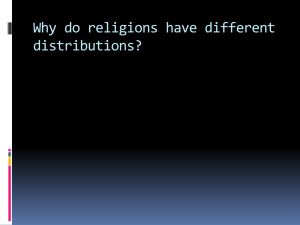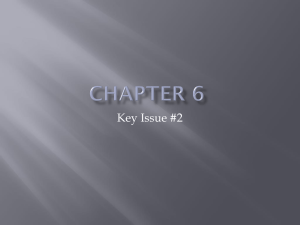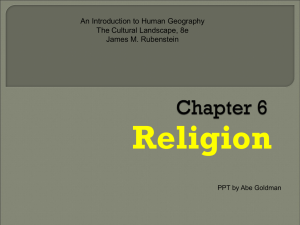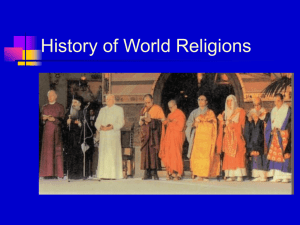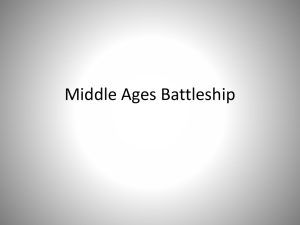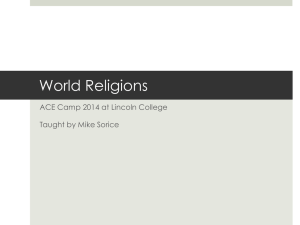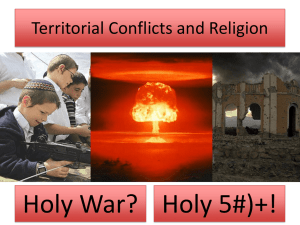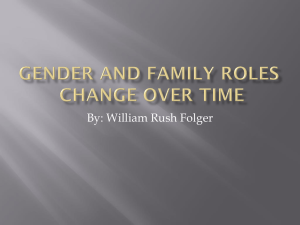Religion - Long Branch Public Schools
advertisement
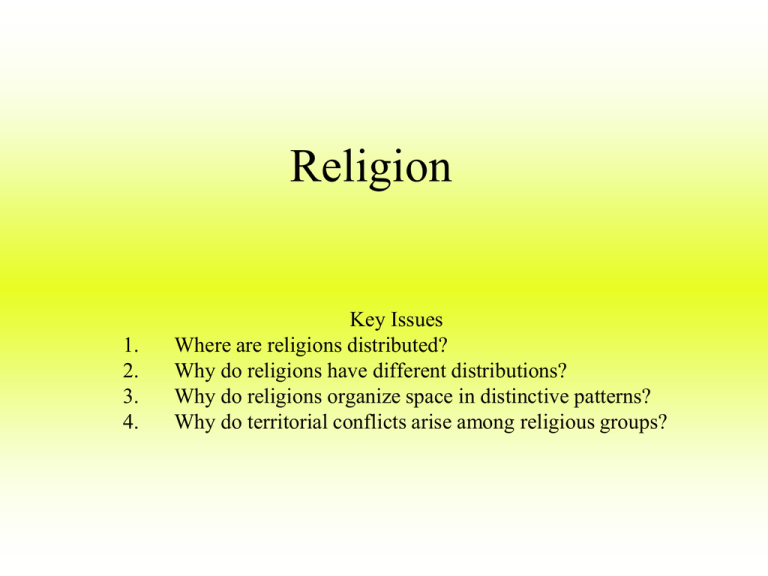
Religion 1. 2. 3. 4. Key Issues Where are religions distributed? Why do religions have different distributions? Why do religions organize space in distinctive patterns? Why do territorial conflicts arise among religious groups? • “There has been more evil done in the name of god then ever good”- Coach Mike Blackman; Baptist Preacher The Roots of Religion Animism (Shamanism) - the belief that all objects, animals, and beings are “animated” or possess a spirit and a conscious life. Also called shamanism because of the prominence of a Shaman. • Such beliefs are common among hunter- gatherers. These were the first people • 10% of Africans follow such traditional ethnic religions. • These beliefs are losing ground to Christianity and Islam throughout Africa. Nigerian Shaman Key Issue 1: Where are religions distributed? • There are 2 types of religions: – Universalizing- religions that attempt to be global and appeal to all people. • The 3 main universalizing religions are: – CHRISTIANITY- BUDDHISM-ISLAM • The other two main universalizing religions other than the above three are: – Sikhism 24 million followers, 21 of which are clustered in the Punjab region of India. – Bahá’í 7 million followers dispersed across the globe. World Distribution of Religions Geographical Distribution Of Major World Religions World Population by Religion Major Religious Hearths Diffusion of Universalizing Religions Each of the three main universalizing religions diffused widely from its hearth. Universalizing Religions • Branches-(Large Fundamental Divisions in religion) – Catholic- Protestant- Greek Orthodox • Denominations (Groups within a branch) – Roman Catholic- Baptist- • Sects (Smaller groups that have broken away) – Ultra Catholic- Southern Baptist- Amish • CHRISTIANITY- 2 billion followers in N. and S. America, Europe, Australia, and some Asian and African countries. • • • • 50% Roman Catholic, 25% Protestant, 10% Eastern Orthodox 15% miscellaneous. – About 90% of the Western Hemisphere is Christian. – 95% Roman Catholic in Latin American – 50% Protestant in the U.S. Universalizing Christianity • Origin: Jesus of Nazareth- 4BCE 29 CE – Off shoot of Judaism- Semitic Hearth (Israel) Prophet was seen as the messiah, Monotheistic- Bible • Diffusion: Expansion and Relocation – – – – • 2 Billion today- largest 312 CE Rome Adopted it Colonial Efforts 90% of the western Hemisphere Branches: – Roman Catholic- Largest Original piece 830 million • Hierarchal Religion- No real denominations • Vatican City- Rome- Autonomous – Protestant- 503 Million- 25% • Broken into denominations- Baptist, Methodist, Lutherans, Pentecostal- 15th century Reformation – Eastern Orthodox- 1054 CE- 192 million- 14 self governing Churches • Russian Orthodox is the largest- Constantinople- “Great Schism” • Cultural Landscape: – – – – Cathedrals- Middle Ages Baroque Church- Catholic Plain Wooden Church- Protestant Cemeteries Diffusion of Christianity Christianity diffused from Palestine through the Roman Empire and continued diffusing through Europe after the fall of Rome. It was later replaced by Islam in much of the Mideast and North Africa. More Detail on the Diffusion of Christianity Christian Branches in Europe Protestant denominations, Catholicism, and Eastern Orthodoxy are dominant in different regions of Europe – a result of many historic interactions. The Religious Situation in Europe, 1560 Population Loss in Germany During the Thirty Years War Christianity in the U.S. • ISLAM- 1.3 billion followers in Middle East, Indonesia, Pakistan, India, Bangladesh. – Core of beliefs is based on the 5 pillars of faith: • There is no god worthy of worship other than the one God, and Muhammad is the messenger of God. • A Muslim must pray 5 times daily facing the city of Mecca. • A Muslim gives generously to charity, as an act of purification and growth. • A Muslim fasts during the month of Ramadan, as an act of selfpurification. • If physically and financially able, a Muslim makes a pilgrimage to Mecca. – The two main branches of Islam are Sunni (83%) and Shiite (16%). Universalizing Islam • Origin: Muhammad 600 CE – Medina, Saudi Arabia, 1.2 billion – Monotheistic- Quran • Diffusion: – Africa, Europe and Asia through Military Conquest – Led to the crusades and ongoing trouble in Africa – Mostly located in Asia and Africa • Branches: – Sunni- “Orthodox”- 85% Also in Bangladesh and PakistanCaliph of the Umayyad and Ottoman are elected “Ayatollah” – Shiite- Majority in Iran- Descendents from Muhammad • Cultural Landscape: – Mosque- four minarets- different from Christian churches – Geometric patterns- images banned – Mecca- Kaaba, Medina, Dome of the Rock Islam • • • • • D R A F T • • • • • Daily Prayer Ramadan Alms Faith Travel to Mecca (Hajj) The 14x46 displays are located on I-26 at mile-marker 125 and US 301N in Orangeburg Prophet: Muhammad Holy Text: Koran Reading the Koran, Brunei Islamic Calender •Begins in AD 622 when Muhammad was commanded to Mecca from Medina (Hijra). •Lunar calendar makes Ramadan move through the seasons (30 year cycle - 19 years with 354 days and 11 with 355). Diffusion of Islam • Origin – Mecca 613 a.d. • Prophet’s death in 1632 – Military expansion – Combined with hierarchical diffusion (social) – Created an Arab empire – Trade as important as religion – Culture, not just religion Diffusion of Islam Islam diffused rapidly and widely from its area of origin in Arabia. It eventually stretched from southeast Asia to West Africa. Distribution of Shia and Sunni Muslims Hajj • BUDDHISM- 365 million followers in China and S.E. Asia mainly. – Based on the 4 Noble Truths: • All living beings must endure suffering. • Suffering, which is caused by a desire to live, leads to reincarnation. • The goal of all existence is to escape from suffering and the endless cycle of reincarnation into Nirvana (a state of complete redemption), which is achieved through mental and moral self-purification. • Nirvana is attained through an Eightfold Path that stresses rightness of belief, resolve, speech, action, livelihood, effort, thought, and meditation. – The branches of Buddhism are Mahayana (56%), Theravada (38%), and Tantrayana (6%). Universalizing Buddhism • Origin: Siddhartha Gautama- 644 BCE – Based off Hinduism – Indo-Gangetic Hearth- Indus and Ganges rivers – North East former India- Nepal • Diffusion: China, to Korea, Japan, Tibet along the silk road – Practically extinct in its mother country – 350 Million world wide • Primary Branches: – Theravada- 55% Monastic- Southeast Asia- Myanmar (Burma), Thailand, Laos, Cambodia- god – Mahayana- 40% Meditation and Prayer- Teacher- Korea, Japan, Vietnam, China – Lamaism- Tibet- Combination- Dali Lama was exiled here by China – Zen- Japanese- Shinto and Buddhism • Cultural Landscape– Pagoda – Bodhi Tree Buddhism • • • • • B E E N N • • • • • Buddha Enlightenment Eightfold Path Noble Truths Nirvana • The perfect proportions of the Buddha’s body corresponds to the design of religious monuments. Its architecture developed from the pre-Buddhist Indian grave-mound. Under these mounds the saintly ascetic were buried; their bodies were seated on the ground and covered with earth. These dome-shaped graves, or tumuli, of the saints were regarded as holy places. And were destinations for pilgrimage for the devotional and places of practice for meditators. • http://www.youtube.com/watch?v=47CW9 LU7yeE • http://www.youtube.com/watch?v=EAY2k m3Oa0s Major Religions of Asia Diffusion of Buddhism Buddhism diffused gradually from its origin in northeastern India to Sri Lanka, southeast Asia, and eventually China and Japan. Buddhism • Third major proselytizing religion • No longer a major presence in the country of its origin Karma - your past bad or good actions determine your progress toward Nirvana through reincarnation. You are your own God. Universalizing Sikhism • Guru Nanak• Syncretism Religion– Blends two religions- Hinduism and Islam – 22 million- Pakistan- • Holy: – Golden Temple in Amritsar, India – Sikhs in Punjab Region of India – Guru Granth Sahib (book) • The second type religion – Ethnic- religion that primarily appeals to one group of people living in one place. More closely tied to the physical geography of a particular region, especially with agriculture. Ethnic Hinduism • Origin: No founder, 900 million – 2000 BCE – Holy Book: Vedas • Diffusion: Indo-Gangetic Hearth – Relocation • Cultural Landscape: Polytheistic – – – – – – – Reincarnation Caste System Mahatma Gandhi- helped free India from England Countless Shrines and temples Cremation Ganges River Ahism Hindu Beliefs and Practice Reincarnation – the soul is immortal but the body endlessly cycles to higher or lower levels of existence. Yoga – the practices or tools used to break from habits of past lives. Includes various meditations and physical practices. The Purusharthas or The Four Aims of Human Life: 1. Dharma (righteousness) 2. Artha (wealth) 3. Kama (desire) 4. Moksha (salvation or liberation) – release from the endless cycles. The Trinity of Brahman Brahma (The Creator) depicted with four faces each continually reciting one of the Vedas. The force of creation and birth. Shiva (The Destroyer) - A hint of monotheismHow does Christianity stack up? Shakti or power; the dissolving force in life; centrifugal force; entropy. Vishnu (The Preserver) - peace; balance; Sustainer of life. Spread of Hinduism Hinduism • • • • R I C K • • • • Reincarnation India Caste System Karma/ Dharma • Ethnic Judaism Origin: Abraham, 18 million, Oldest Monotheistic 2000 BCE – – – – • Semitic Hearth Jerusalem Christianity and Islam Torah and Talmud Diffusion: – Diaspora – 66% of all Jews live in Israel and the USA – 1948 official home land • Branches – Orthodox- traditional – Reformed- 1800’s- modern Judaism – Conservative- Moderate- the most recent • Cultural Landscape: – Synagogue – Star of David – Western Wall • Right next to the Dome of the Rock – Zionism Ethnic Shintoism and Shamanism • Shinto- Japan- 118 Million- SyncreticBuddhism and Shamanism • Shamanism- Shaman- Africa, Americas, Asia – Animism- Spirits of the Environment Ethnic Taoism and Confucianism • Taoism- Laozi 600 BCE – Feminist, Harmony, Feng shui • Confucius- Confucius 600 BCE – Worldly not heavenly – East Asia predominately- Most influential thought – Relationships Confucianism and Daiosm • Five relationships • Filial Piety • Nature Religious Organization • New Religious Movements or Cults – New religious movement (NRM): small secretive religious groups that represent either a new religion or a major innovation of an existing faith • Similar to sects • Tend to be small • Viewed as less respectable than more established faiths How do Universalizing and Ethnic Religions Differ? Universalizing •Appeal to people everywhere •Individual founder (prophet) •Message diffused widely (missionaries) •Followers distributed widely. •Holidays based on events in founder’s life. Ethnic •Has meaning in particular place only. •Unknown source. •Content focused on place and landscape of origin. •Followers highly clustered. •Holidays based on local climate and agricultural practice. • Which type religion has more bearing on the global landscape? • How does ethnic religions try and hold their identity • Give three examples of positive influences and three negative • How is this either unsuccessful or successful in today’s culture Key Issue 2: Why do religions have different distributions? • As a general rule, universalizing religions have origins based on a specific individual’s life in the past, ethnic religions typically have either no origin or an unclear one at best. • Some religious origins: – Christianity- based on the life of Jesus – Islam-trace lineage back through Abraham’s other son Ishmael; based on the life of Muhammad, the Prophet of Islam. – Buddhism- based on the life of Siddhartha Gautama, who later became Buddha (the enlightened one) – Sikhism- founded by Guru Nanak about 500 years ago. • Hindu- did not originate with a specific founder. Beginnings of Hindu date back to before recorded history. It is the oldest living religion • Missionaries- individuals who help to transmit a universalizing religion through relocation diffusion. • Pagan- followers of polytheistic religions in ancient times. • Ghetto- city slum designated for Jew habitation. • Cosmogony- creation story. • Solstice- day when sun is at highest or lowest point in the sky. • Diffusion of Religions – Christianity spread mainly through the work of missionaries, and also by some conquest and colonization. – Islam spread mainly through conquest. – Buddhism spread mainly through missionaries and trade merchants. • Buddhism and Islam are the universalizing religions that place the most emphasis on identifying shrines/holy places. – In universalizing religions, the holy places are generally locations at which memorable events happened in the founder’s life • Mecca is in Islam because it is Muhammad’s birthplace. • Holy places in ethnic religions are often physical features that are closely tied to the religion. – Hindu one of the most important rituals is the bathing of oneself in the Ganges River. Diffusion of Christianity Diffusion of Islam Islam is considered the fastest growing religion in America. Only a small part of this growth is from black Muslims and the Nation of Islam. Diffusion of Buddhism • Ethnic religions rarely diffuse, and when they do, it is to a small extent. • universalizing religions diffuse mainly at the expense of the smaller ethnic religions, and often a semihybrid religion will result with concepts from both the ethnic religion and the universalizing religion intertwined. – Judaism is an exception in that it has diffused widely throughout the years, mainly because its people have had to flee persecution from many areas in the world. • Cosmogony and calendars also differ betwixt universalizing religions and ethnic religions. – Ethnic religious creation stories tend to deal with the physical environment and natural events – Ethnic religions typically organize their calendars around the seasons, other natural events, or the physical geography. – universalizing religion stories often attempt to explain the mystical. – Universalizing religions’ main purpose in calendars is to commemorate events in the founder’s life, thus the seasons or weather are not central to the structure. Syncretism - the mixing of two or more religions that creates unique rituals, artwork, and beliefs. Examples include syncretism of Christianity and indigenous beliefs in the Americas, Africa, and Asia. Voodoo Dolls, Haiti • Caribbean Voodoo (Haiti, Louisiana) • Christianity in Indigenous Latin American Shrine, Bangalore, India Syncretism - the mixing of two or more religions that creates unique rituals, artwork, and beliefs. Variations in Distribution of Religions (2) • Holy places – Holy places in universalizing religions – Holy places in ethnic religions • The calendar – The calendar in ethnic religions – The calendar in universalizing religions Holy Sites in Buddhism Most holy sites in Buddhism are locations of important events in Buddha’s life and are clustered in northeastern India and southern Nepal. Mecca, Islam’s Holiest City Fig. Makkah (Mecca) is the holiest city in Islam and the site of pilgrimage for millions of Muslims each year. There are numerous holy sites in the city. Hindu Holy Places Hierarchy of Hindu holy places: Some sites are holy to Hindus throughout India; others have a regional or sectarian importance, or are important only locally. Key Issue 3: Why do religions organize space in distinctive patterns? • The distribution of religious elements on the landscape reflects the importance of religion in people’s values. – In Christianity, the landscape is dominated by a high density of churches. They are critical because of the emphasis placed on regularly attending worship. – In Islam, mosques are the places for general assembly. They are not viewed as a sanctified place but rather a convening point for the community. A mosque normally has a central courtyard surrounded by classrooms. – In Hinduism, temples are built within the home or individual community. They have a central room to house a spirit, with rooms for rituals, and outer purifying pools. – In both Buddhism and Shinto, pagodas are the common architecture. They are typically built to enshrine sacred religious artifacts. – In Bahá’í, the church officials decided to open seven Houses of Worship on multiple continents to stress the universality of their religion. Religion and Environment • Burial practices – Judeo-Christians bury. – Hindus and Buddhists cremate. • Relationship with nature – Sacred Spaces – Sacred architecture – Role of religion in domination of earth? – The disposing of the dead differs from religion to religion. Some prefer to bury while others choose to cremate. • Religion often influences the place-names of certain regions. – Ex. The vast amount of places named for saints in predominantly Roman Catholic Quebec. • Hierarchical religion- well-defined geographic structure with a high degree of organization. Ex. The Roman Catholic Church • Diocese- the basic geographic unit of the R.C.C. • Autonomous religions- self-sufficient religions with little organization. Ex. Islam prefers to unify by faith rather than specific boundaries. • Most ethnic religions are autonomous. Protestant faiths vary. Organization of Space • Places of worship – Christian worship – Places of worship in other religions • Sacred space – Disposing of the dead – Religious settlements – Religious place names • Administration of space – Hierarchical religions – Locally autonomous religions Place Names in Québec Place names in Québec show the impact of religion on the landscape. Many cities and towns are named after saints. Roman Catholic Hierarchy in U.S. Fig. 6-13: The Catholic church divides the U.S. into provinces headed by archbishops. Provinces are divided into dioceses, headed by bishops. Hierarchical Religions • A hierarchical religion has a well-defined geographic structure and organizes territory into local administrative units, i.e. Roman Catholicism and Latter-Day Saints (Mormons) • Pope Cardinal Archbishop Bishop Priest Hierarchy of the Catholic Church Roman Provinces Roman Catholic Church Membership as a Percentage of Each Country's Population Hierarchy of the Church of Jesus Christ of Latter-Day Saints Key Issue 4: Why do territorial conflicts arise among religious groups? • RELIGION IS ARGUABLY THE MOST VOLITALE OF ALL HUMAN RELATIONS AND THE SOURCE OF MOST VIOLENCE THROUGHOUT HISTORY. • Fundamentalism- the literal interpretation and strict intense adherence to one’s religious principles. – Fundamentalists try to return society to its religious ways. The most obvious example is the Taliban in Afghanistan. • Caste- the class or distinct hereditary order into which a Hindu was assigned according to religious law. Religious Conflicts • Religion vs. government policies – Religion vs. social change – Religion vs. Communism • Religion vs. religion – Religious wars in the Middle East – Religious wars in Ireland Secularism and Theocracy • Secularism- movement away from religion controlled life • Theocracy- opposite- government is run by a religion – Afghanistan- Taliban – Iran- Ayatollah Conflict • “There has been more evil done in the name of God then ever good”- Coach Mike Blackman; Baptist Preacher • Interfaith Boundaries- Divide between two or more religions – – – – – China- Tibet Buddhism vs. Chinese Atheism Nigeria- Islam vs. Christianity India- Sikhism vs. Hinduism- Punjab region India and Pakistan- Hinduism and Islam- 1947 Former Yugoslavia- Serbia- Christians vs. Muslims1990’s – Palestine- Jews vs. Muslims Intrafaith Conflicts • Iraq- Sunni and Shiite- Govt control • USA- Fundamentalist and Moderate liberal- Homosexuality, Evolution, abortion (SNL the Devil) • Northern Ireland- IRA- Protestants and Catholics- Irish Independence Social Impact of Religion • Gender roles – Women’s rights • Diet – Vegetarian s – Pork, beef – Alcohol • Ethics and morals • Schools and institutions World Distribution of Hogs • • • • • • • • • • • • • • • • • • • • • • • • • • What the Bible says about Women's Rights Genesis 3:16 Unto the woman he said, I will greatly multiply thy sorrow and thy conception; in sorrow thou shalt bring forth children; and thy desire shall be to thy husband, and he shall rule over thee. 1 Corinthians 14:34-36 Let your women keep silence in the churches: for it is not permitted unto them to speak; but they are commanded to be under obedience as also saith the law. And if they will learn any thing, let them ask their husbands at home: for it is a shame for women to speak in the church. Ephesians 5:22-24 Wives, submit yourselves unto your own husbands, as unto the Lord. For the husband is the head of the wife, even as Christ is the head of the church: and he is the saviour of the body. Therefore as the church is subject unto Christ, so let the wives be to their own husbands in every thing. Colossians 3:18 Wives, submit yourselves unto your own husbands, as it is fit in the Lord. 1 Timothy 2:11-15 Let the woman learn in silence with all subjection. But I suffer not a woman to teach, nor to usurp authority over the man, but to be in silence. For Adam was first formed, then Eve. And Adam was not deceived, but the woman being deceived was in the transgression. Notwithstanding she shall be saved in childbearing. Titus 2:4-5 Teach the young women to be ... obedient to their own husbands, that the word of God be not blasphemed. 1 Peter 3:1 Likewise, ye wives, be in subjection to your own husbands. The Quran 2:228 "(Women) have rights similar to those (of men) over them in kindness, and men are a degree above them." 2:282 "And call two witness from among your men, two witnesses. And if two men be not at hand, then a man and two women." 4:3 "Marry of the women, who seem good to you, two or three or four." 4:11 "To the male the equivalent of the portion of two females, and if there be women more than two, then theirs is two-thirds of the inheritance, and if there be one (only) then the half." 4:34 "Men are in charge of women, because Allah hath made the one of them to excel the other, and because they spend of their property (for the support of women). So good women are the obedient, guarding in secret that which Allah hath guarded. As for those from whom ye fear rebellion, admonish them and banish them to beds apart, and scourge them." 4:176 "Unto the male is the equivalent of the share of two females." 24:31 "And tell the believing women to lower their gaze and be modest, and to display of their adornment only that which is apparent, and to draw their veils over their bosoms, and not to reveal their adornment save to their own husbands. ... And let them not stamp their feet so as to reveal what they hide of their adornment." 33:30 "O ye wives of the Prophet! Whosoever of you committeth manifest lewdness, the punishment for her will be doubled, and that is easy for Allah." 33:32-33 "O ye wives of the Prophet! Ye are not like any other women. ... Stay in your houses." 33:53 "When ye ask of them (the wives of the Prophet) anything, ask it of them from behind a curtain. That is purer for your hearts and for their hearts. And it is not for you to cause annoyance to the messenger of Allah, nor that ye should ever marry his wives after him. Lo! that in Allah's sight would be an enormity." 33:59 "O Prophet! Tell thy wives and thy daughters and the women of the believers to draw their cloaks close round them (when they go abroad)." 66:5 "If he [Muhammad] divorce you, will give him in your stead wives better than you, submissive (to Allah), believing, pious, penitent, devout, inclined to fasting, widows and maids • Religion is nearly always suppressed in communist countries. – Leaders believe that religion has a tendency to upset stability and therefore ban it altogether, though often they just concrete the people’s religious adherence instead of destroying it. • Other times, when people of different religions live in close proximity to one another, engage in contact often, or share interests in a particular location, especially violent interaction will occur. – Ex. The Middle East. Jews, Christians, and Muslims have fought for over 2,000 years to control the same small strip of land in the East Mediterranean. – Historically the Crusades between Christians and Muslims played out as each fought to control the Holy Lands. – Hostilities continue in the modern era over these same lands. • The controversy in Ireland occurred when predominantly Catholic South Ireland wished to secede from predominantly Protestant Great Britain. – However, the northernmost six counties of Ireland are overwhelmingly Protestant and wished to remain part of the U.K. – When the split occurred a small number of Roman Catholics in both N. Ireland and the Republic of Ireland joined the Irish Republican Army (IRA), a militant organization devoted to achieving Irish unity by whatever means necessary. – A Protestant organization has formed in return. • Violence continues as extremists from both sides disrupt the lives of peaceful civilians. • “Bloody Sunday” – U2 Distribution of Protestants in Ireland, 1991 When Ireland became independent in 1937, 26 northern districts with large Protestant populations chose to remain part of the United Kingdom. Distribution of Catholics in Belfast Boundary Changes in Palestine/Israel Topics of Discussion • Religious culture regions, diffusion & distribution • Religious ecology, or the relationship between religion and the physical environment – How do different people view and use their environment? – What imprint do different religions leave on their environment? • Relationship between religion and culture, economic and political systems • Religious conflicts Religious Conflict The Big Question: Can secular society exist alongside traditional and fundamentalist religious sects and states? • We are quick to notice fundamentalism abroad (i.e. Salman Rushdie’s death sentence by Shia clerics) and not so quick to recognize it at home (abortion clinic bombings; Southern Baptist Convention’s calls for women to submit to their husbands’ authority). • American evangelical Christianity and Islamic fundamentalism are the two most influential fundamentalist movements in the world. • Fewer and fewer states are governed by an official church. Key Concepts • Methods of religious diffusion • Cultural hearth of a religion • Animistic religion • Ethnic religion • Universal or universalizing religion • Sacred space • Pilgrimages • Religious toponyms • • • • • • • • • • • Religious branch Religious denomination Religious sect Menifacts Sociofacts Artifacts Shia & Sunni Muslims Shintoism Hierarchical religions Ecclesiae Religious cults • Rubenstein, James- Cultural Landscape; An Introduction to Human Geography • http://www.glendale.edu/geo/reed/cultural/c ultural_lectures.htm • http://www.quia.com/pages/mrsbellaphg.htm l • Ike Heardhttp://geoearth.uncc.edu/people/iheard/1105 syllabus.html • Google
